
Grilling a delicious ribeye steak on your gas grill is a true art that can transform your backyard BBQ into an unforgettable experience. This comprehensive guide will teach you how to achieve amazing results every time. From selecting the best cut to mastering the perfect grilling technique, you’ll impress your guests with juicy, flavorful steaks that steal the show.
Key Takeaways
- Understand how to choose the best ribeye steak for grilling
- Learn effective techniques for preparing the steak for the grill
- Discover flavorful seasoning and marinade options to enhance the steak
- Master the art of controlling your gas grill’s temperature and heat zones
- Achieve the perfect doneness by mastering grilling methods like searing and reverse searing
- Ensure your grilled ribeye steak is perfectly rested and ready to serve
- Utilize gas grill cooking to elevate your ribeye steak experience
Selecting the Perfect Ribeye Steak
Choosing the right ribeye steak is essential when grilling this flavorful cut of beef. Whether you’re a seasoned pro or new to the grill, knowing how to pick the perfect ribeye can transform your dish. It’s all about finding the right balance between marbling, thickness, and quality to ensure a juicy, tender, and delicious steak every time.
Cut and Quality
When shopping for ribeye steaks, look for those with good marbling—meaning fat evenly dispersed throughout the meat. This marbling is what makes the steak juicy and flavorful when grilled. For the best results, opt for USDA Choice or Prime grades, as they offer superior tenderness and rich beef flavor.
Size and Thickness
The size and thickness of the steak affect how it grills and tastes. Choose steaks that are 1 to 1.5 inches thick for a great sear and even cooking. Bone-in steaks taste richer, but boneless ones are easier to grill.
| Steak Cut | Flavor | Tenderness | Recommended Thickness |
|---|---|---|---|
| Bone-in Ribeye | More Robust | Tender | 1 – 1.5 inches |
| Boneless Ribeye | Slightly Less Robust | Tender | 1 – 1.5 inches |
Knowing how to pick the right ribeye steak seasoning will help you grill a delicious dish. Your guests will love it, and you’ll enjoy every bite.
Preparing the Ribeye Steak for Grilling
Grilling a delicious ribeye steak on your gas grill starts with proper preparation to ensure great results. Following a few simple but essential steps can significantly enhance the flavor and texture of your steak, making every bite a memorable experience.
Start by letting your ribeye steak warm up to room temperature before grilling. This makes the meat cook more evenly, leading to a juicier and tender steak. Take the steak out of the fridge 30 minutes to an hour before grilling.
Then, dry the steak with paper towels. This step helps create a better sear, locking in juices and giving a beautiful crust. Ensuring the steak is thoroughly patted dry is key for how to grill a ribeye steak on a gas grill.
The secret to a perfectly grilled ribeye steak lies in thorough preparation. Allow the steak to come to room temperature and pat it dry before grilling—these simple steps will reward you with a juicy, tender, and flavorful steak every time.
By following these tips, you’re on your way to becoming a pro at how to grill a ribeye steak on a gas grill and gas grill cooking. You’re ready to season, marinate, and grill your way to a memorable meal.

Seasoning and Marinating the Ribeye Steak
Getting the best flavor from your grilled ribeye steak is essential for a memorable meal. You can enhance your steak with a bold dry rub or a flavorful marinade. Let’s explore some great ways to take your how to grill a ribeye steak on a gas grill technique to the next level and make every bite even better.
Dry Rub Recipes
A flavorful dry rub is easy to make and creates a delicious crust on your ribeye steak seasoning. Start with spices and herbs that match the steak’s rich taste. Some top dry rub ingredients are:
- Coarse salt and black pepper
- Garlic powder
- Onion powder
- Smoked paprika
- Chili powder
- Dried thyme or oregano
Combine the dry ingredients well, then rub it all over the steak. Let it sit for 30 minutes to an hour before grilling to soak up the flavors.
Marinade Options
For a steak that’s juicy and full of flavor, try some delicious ribeye marinade recipes. Marinades typically combine an acid—such as vinegar or citrus juice—with oil, along with a blend of spices and herbs. The acid helps to tenderize the meat, while the oil and seasonings infuse it with rich, mouthwatering flavor.
Here are some marinade ideas:
- Balsamic and herb: Balsamic vinegar, olive oil, garlic, thyme, and rosemary
- Teriyaki: Soy sauce, brown sugar, ginger, and garlic
- Red wine: Red wine, Dijon mustard, Worcestershire sauce, and black pepper
Marinate your ribeye for at least 2 hours, or up to 24 hours for the best flavor. Make sure to flip the steak a few times so it marinates evenly.
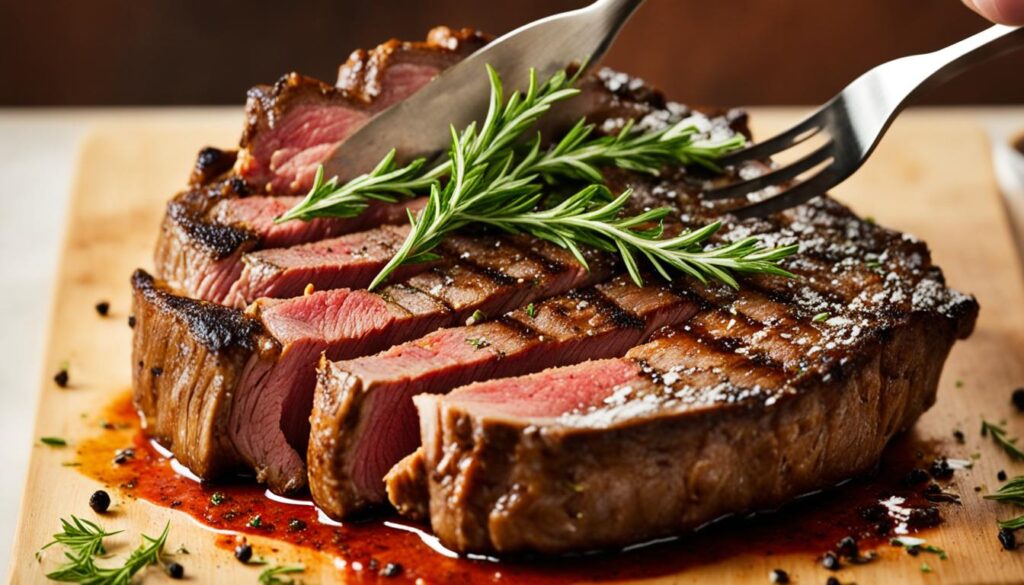
“The key to a truly great grilled ribeye is all in the preparation. Experiment with different dry rubs and marinades to find the flavors that suit your taste buds best.”
How to Grill a Ribeye Steak on a Gas Grill
Grilling a juicy and flavorful ribeye steak on a gas grill is truly an art. It demands precise temperature control and careful timing. Mastering key techniques like searing, monitoring the internal temperature, and managing your grill’s heat zones is essential. By perfecting these skills, you can consistently achieve steakhouse-quality results right in your own backyard.
Start by preheating your gas grill to a high temperature, around 450-500°F (232-260°C). Create a direct heat zone for this. This high heat is crucial for searing the exterior of the how to grill a ribeye steak on a gas grill. It locks in the natural juices and develops a delicious caramelized crust.
- Place the ribeye steak directly over the hot, direct heat zone and sear for 2-3 minutes per side, or until a beautiful, golden-brown crust forms.
- After searing, move the steak to the indirect heat zone of the grill, where the temperature is slightly lower, around 375-400°F (190-204°C).
- Continue grilling the steak, flipping it every 2-3 minutes, until it reaches your desired level of gas grill cooking doneness.
Use a reliable meat thermometer to monitor your steak’s internal temperature. For perfect medium-rare doneness, aim for an internal temperature between 130°F and 135°F (54–57°C). Adjust your grill’s heat zones as needed to maintain this optimal temperature throughout the cooking process, ensuring a juicy and flavorful steak every time.
| Steak Doneness | Internal Temperature |
|---|---|
| Rare | 125-130°F (52-54°C) |
| Medium-Rare | 130-135°F (54-57°C) |
| Medium | 140-145°F (60-63°C) |
| Medium-Well | 150-155°F (66-68°C) |
| Well-Done | 160°F (71°C) and above |
By following these steps, you’ll be able to grill a mouthwatering ribeye steak. It will be perfectly seared on the outside and cooked to your desired doneness on the inside. Enjoy the delicious results of your how to grill a ribeye steak on a gas grill culinary skills!
Gas Grill Setup and Temperature Control
Learning to grill a ribeye steak on a gas grill means setting it up right and controlling the heat. It’s important to know the difference between direct and indirect heating zones. This knowledge helps get the perfect sear and cooks the steak evenly.
Direct and Indirect Heating Zones
For the best grilling results, set up both direct and indirect heat zones on your gas grill. The direct heat zone, positioned right over the flame, is perfect for searing and creating a flavorful brown crust on your steak. This helps lock in juices and enhance flavor. Meanwhile, the indirect heat zone, located away from the flame, gently cooks the inside to your preferred doneness without overcooking the exterior.
- Direct Heating Zone: Place the steak over the active burners to sear and caramelize the exterior.
- Indirect Heating Zone: Move the steak to the grill area without burners for slow cooking to your preferred doneness.
Getting the temperature right is key when grilling a ribeye steak on a gas grill. Keep the direct zone hot (450°F-550°F) for searing. Use a lower temperature (300°F-400°F) in the indirect zone for even cooking.
“The key to grilling a perfect ribeye steak on a gas grill is understanding how to create and manage the right balance of direct and indirect heat.”
With direct and indirect heating zones properly set up and temperatures controlled, you’re ready to grill a delicious, restaurant-quality ribeye steak every time.
Grilling Techniques for Perfect Ribeye Doneness
To get the perfect doneness for your grilled ribeye steak, learn key techniques like searing and reverse searing. These methods create a tasty, caramelized crust and cook the inside to your liking. This results in a juicy, flavorful steak.
Searing for a Flavorful Crust
Searing is essential when grilling a ribeye steak on a gas grill. Using high, direct heat creates a savory, golden-brown crust on the outside while keeping the inside tender and juicy. Begin by heating your gas grill to its highest setting to achieve that perfect sear.
Then, place the steak directly over the flames. Sear for 2-3 minutes per side, until the outside is nicely charred.
Reverse Searing for Consistent Doneness
The reverse searing method cooks the steak at a lower temperature first, then sears it at high heat. This locks in juices and cooks the inside evenly. Start with your gas grill at a lower heat, around 275-300°F.
Place the steak on the grill and cook until it reaches your desired doneness, usually 10-15 minutes for a 1-inch thick ribeye. When the steak is almost done, increase the heat and sear it for 1-2 minutes per side. This creates the signature crust.
Mastering these grilling techniques will help you serve perfectly cooked, delicious ribeye steaks every time you grill.
Resting and Serving the Grilled Ribeye Steak
After grilling your ribeye steak, be sure to let it rest before slicing and serving. This crucial step allows the juices to redistribute evenly, resulting in tender, juicy meat. Resting your steak enhances both its flavor and texture, making every bite truly delicious.
Once your ribeye steak is cooked to your liking, transfer it to a cutting board and let it rest for 5-10 minutes. This resting period allows the steak to absorb its juices, making it even tastier and juicier. Serve alongside your favorite sides, such as roasted vegetables or a fresh salad, for a delicious and complete meal.
Resting and serving your grilled ribeye steak the right way can take your meals to the next level. Enjoy the delicious outcome of your grilling skills and relish every bite of your perfectly cooked steak.

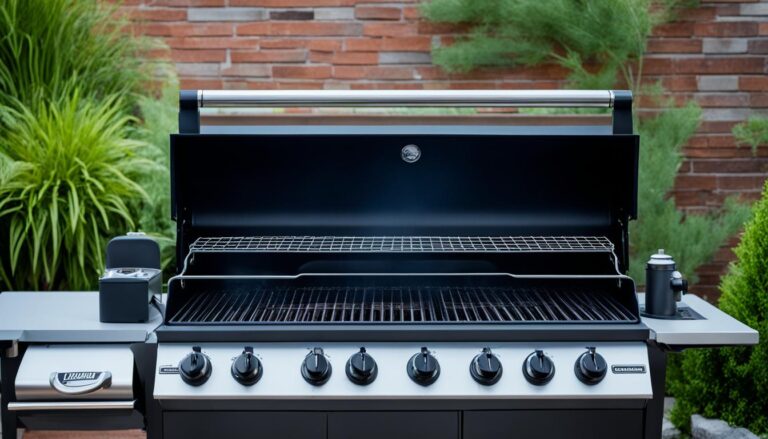
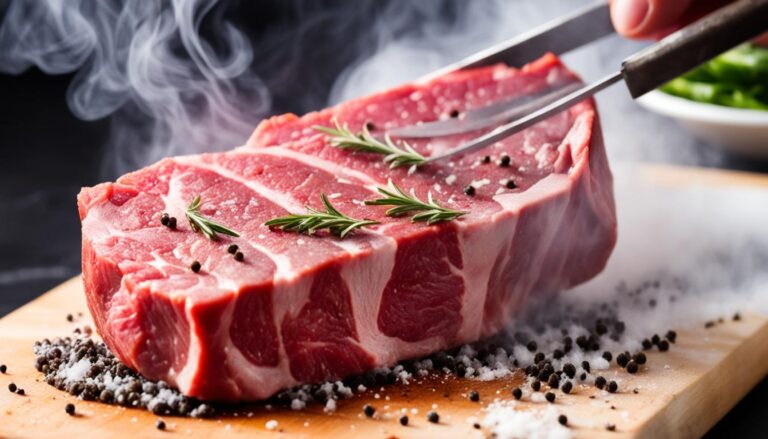
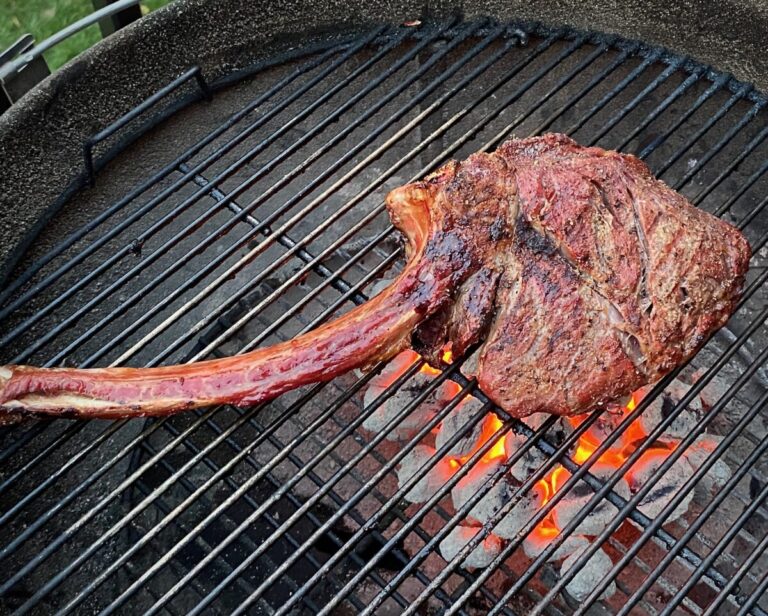
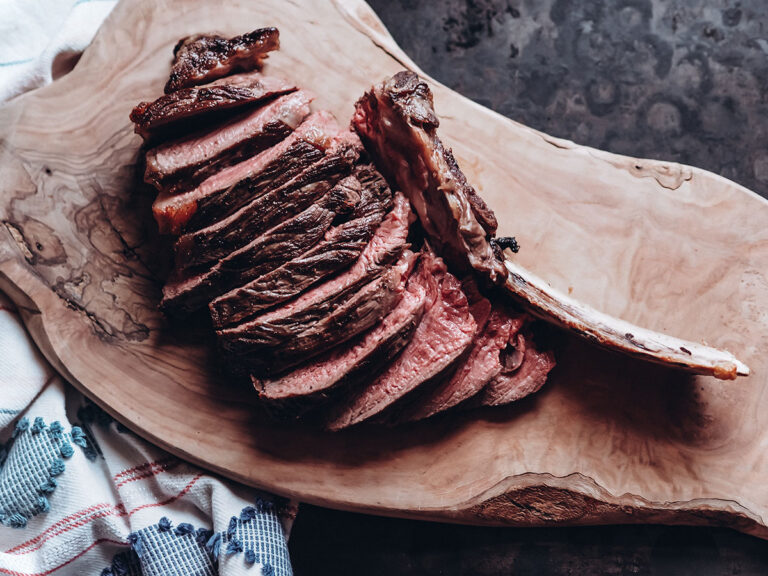
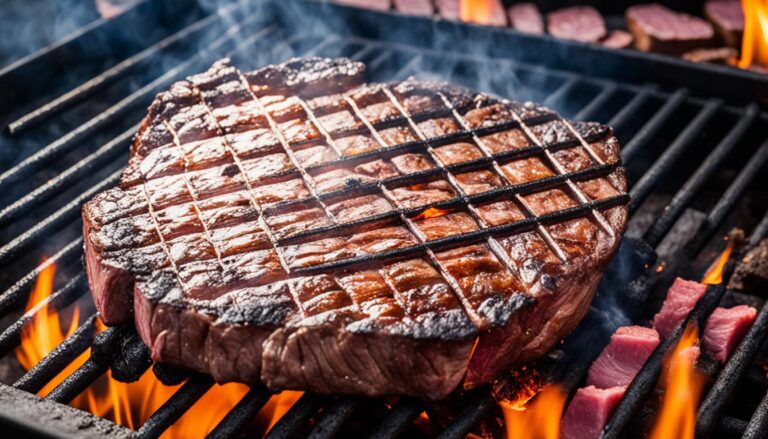

3 Comments